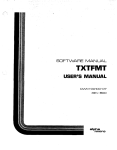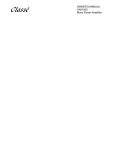Download Classe Audio CA-200 Owner`s manual
Transcript
CA-200 ISSUE 3 DEC. ‘97 CLASSÉ AUDIO CA-200 POWER AMPLIFIER CA-200 OWNER'S MANUAL CA-200 ISSUE 3 DEC. ‘97 CLASSÉ DESIGN PHILOSOPHY 1. REPEATED LISTENING DESIGN SESSIONS: Fine tuning of sound by exchanging and mixing of parts (transistors, capacitors, wiring, PCB boards etc.), and adjusting many specific operating voltages within proper engineering ranges, producing an overall sonic recipe giving the most natural harmonic realism of music typical of instruments in a live performance. 2. UPGRADABLE SINGLE CIRCUIT DESIGNS: All Classé products (all preamps and all amps) share exactly the same circuit (excluding moving coil and moving magnet phono circuits). This means all amplifiers and all high level circuits of the preamps are the same. The same circuit is tailored to different power levels etc. Differences between less expensive models and more expensive models are parts quality and compliment, power supply extravagance and the amount of filtering etc., as well as features and packaging. This means that for years Classé has been constantly fine tuning and upgrading this circuit and its application, thus reaching a very high level of understanding and musical achievement which benefits all models - least expensive, most expensive, preamps and amplifiers alike. 3. EXTREME LONG LIFE IN REAL WORLD CONDITIONS: Choosing the best attainable quality parts and materials combined with the advantages of the two above-mentioned areas provides Classé owners with years of proven trouble free reliability and musical enjoyment. -2- CA-200 ISSUE 3 DEC. ‘97 CA-200 OWNER'S MANUAL TABLE OF CONTENTS UNPACKING & SET-UP............................................................... 4 GENERAL CONNECTIONS.......................................................... 5 CONNECTIONS FOR REGULAR OR BALANCED INPUTS ... 8 PROTECTION CIRCUIT................................................................ 10 CA-200 BACK VIEW....................................................................... 11 CA-200TOPVIEW..............................................................................12 SPECIFICATIONS........................................................................... 14 -3- CA-200 ISSUE 3 DEC. ‘97 UNPACKING & SET-UP Your CLASSÉ CA-200 power amplifier is packed in high density, semi-rigid foam placed in a special cardboard box. To remove the unit, open and spread all the top flaps of the box and by its sides, lift out the entire unit and put it on a large flat surface. Take it out of the plastic bag and inspect the unit for any concealed damage. Apart from this owner's manual, please ensure the following has also been included: 1) Detachable A.C. linecord 2) Allen key for top plate 3) Nut driver for output connectors Please report any damage or missing parts to your dealer immediately. Place the CA-200 at or near its final set-up position, allowing 8 inches at the rear for tightening the speaker output connectors. For optimum sonic performance, we recommend the optional CLASSÉ REFERENCE A.C. LINECORD. Consult your dealer regarding this accessory. The power transformer in the CA-200 is located at the front-center of the unit. Ideally, a few feet should separate this area from components which potentially could pick up hum. These include preamplifiers, turntables, and interconnect cables. In terms of providing adequate airspace for cooling, a good rule of thumb is to allow 6 inches above and 3 inches on each side of the unit. Check the Serial Number sticker on the back of the unit for the correct operating voltage. The CA-200 has one external AC fuse, the rating of which should be as follows: LINE VOLTAGE 100 or 120 V.A.C. FUSE RATING 10 AMP SLOW BLOW 125 or 250 volts 220 or 240 V.A.C. 8 AMP SLOW BLOW 250 volts -4 CA-200 ISSUE 3 DEC. ‘97 GENERAL CONNECTIONS A.C. LINE Insert the linecord into the A.C. receptacle on the rear of the unit. CAUTION: SAFETY INSTRUCTIONS DISCONNECT AC LINE CABLE WHILE MAKING ALL CONNECTIONS. "FLOATING THE GROUND” OR DEFEATING THE GROUND ON A 3-PRONG LINECORD MAY CREATE A SHOCK HAZARD. CONNECT ALL INTERCONNECT CABLES BETWEEN THE ELECTRONICS BEFORE CONNECTING THE A.C. LINECORDS TO THE WALL OUTLETS. THIS WILL REDUCE THE POTENTIAL SHOCK HAZARD. STEREO Input and output connectors are clearly marked on the back of the amplifier. Left/Right connections are oriented from the front of the unit. Stereo output connections are marked above the connectors. Switch stereo/mono switch to STEREO position. (The CA-200 is preset at the factory for STEREO.) Use only high quality interconnect and loudspeaker cables, and make all connections tight. If the RCA input plugs are loose, remove them and pinch down the ground leaves slightly with pliers. Observe correct phasing of the loudspeaker connections, and tighten. DO NOT OVERTIGHTEN the output connectors. -5 CA-200 ISSUE 3 DEC. ‘97 MONO Please read through the previous Stereo section for general notes on securing good connections, and safety tips. If the unit has been previously used in stereo, make sure it is OFF, and remove all connections, including the AC line cable. Make sure the STEREO/MONO switch is switched to the MONO position. NOTE: The Stereo-Mono switch will not operate if the amplifier is turned on, you will NOT be able to change from one mode to the other, as the mode is “locked” while the amplifier is on. The MONO "Input" is the "left channel input", as marked. The unused right channel input is automatically disconnected. Correct output phase MONO connections are marked below the connectors. Repeat the above MONO settings and connections on the second CA-200 to be used for the other channel. Please remember that the negative output connection of a bridged amplifier is NOT a ground. Do not use a "common ground” switch-box set-up. Do not use with electronic crossovers which have a common ground. Connecting two bridged amplifiers to a common ground device of any sort will cause the amplifiers to fail. REMOTE CONTROL: (OPTIONAL) With a simple connection from a ClassJ “Remote Interface Box” to the remote jack at the back of the amplifier, (see Figure 1) the CA-200 can be turned ON or OFF from a distance (or from another room). The “Remote Interface Box” repeats the information sent to the LED on the front of the amplifier, allowing remote mounting of the amplifier. -6 CA-200 ISSUE 3 DEC. ‘97 IR OUT and IN: The CA-200 may also be turned on and off using our SSP-50 Surround Sound Processor, utilising the IR OUT and IN jacks. To turn on your CA-200 with the SSP-50, Disconnect you CA200 from the AC line completely, open the top cover and locate the 4 internal jumpers inside the CA-200 (see fig. 2, page ) alongside the mosfet fuses. When facing the amplifier from the front, remove the jumper located completely to the right and save this jumper. Re-install the top cover. Install a mini jack into IR IN at the back of the CA-200 and plug the other end of the mini jack into the 5VDC mini jack at the back of your SSP-50. When the Standby button of the SSP-50 is pressed, it will now activate the turn on turn off circuitry of your CA-200. Several amplifiers may be turned on automatically in sequence or all at once, depending upon the configuration of the jumper settings in the amplifier. You will find these jumpers located inside the unit (see fig.2 page) alongside the mosfet fuses. The table below tells you which jumper should be inserted or removed to obtain the correct sequence on which you will want your amplifier to turn on. J3 J2 J1 J0 ADRESS RC Button Auto ON X X X X 0 Amp 1 No X X X out 1 Amp 2 No X X out X 2 Amp 3 No X X out out 3 Amp 4 No X out X X 4 Amp 5 No X out X out 5 Amp 6 No X out out X 0 Amp1 No X out out out 0 Amp 1 Yes -7 CA-200 ISSUE 3 DEC. ‘97 SEQUENTIAL TURN ON Your CA-200 is factory set as being the 1st amp (AMP 1) to be turned on in sequence. To reprogram your unit so that it would be the 2nd , 3rd, 4th, 5th or 6th amp to be turned on in sequence you have to follow this procedure. Push and hold the power button, when the LED becomes solid green, depress the button and then press again. The number of times you will press again will determine when the amplifier will turn on in the sequence. See example on the next page. EX: Push and hold power button until solid green, when power LED is solid green, depress button and then push 2 times. Then your amplifier will be the 2nd one to turn on in the sequence. -8 CA-200 ISSUE 3 DEC. ‘97 CONNECTIONS FOR REGULAR OR BALANCED INPUTS: The CLASSÉ CA-200 power amplifier is equipped with both regular and balanced inputs. Either one may be used SEPARATELY, BUT NOT SIMULTANEOUSLY. The balanced inputs must be connected to a preamplifier which has balanced main outputs. Balanced interconnects with "XLR" connectors are also required. Regardless of the amplifier inputs used, stereo or mono operation is possible on the CA-200. REGULAR INPUTS Switch the REGULAR/BALANCED switch to the position marked "REGULAR". (The amplifier is factory set for “REGULAR”.) NOTE: The REGULAR/ BALANCED switch will not operate if the amplifier is turned on; you will NOT be able to change from one mode to the other, as the mode is “locked” while the amplifier is on. Connect the regular interconnects to the RCA input jacks on the rear panels of the CA-200. The balanced connectors are automatically disabled. BALANCED INPUTS Switch the REGULAR/BALANCED switch to the position marked "BALANCED". A balanced preamplifier and balanced interconnects are also required. NOTE: The REGULAR/ BALANCED switch will not operate if the amplifier is turned on; you will NOT be able to change from one mode to the other, as the mode is “locked” while the amplifier is on. For use with balanced preamplifiers other than Classé, the wiring of the 3-pin XLR connectors must be matched to that of the CLASSÉ CA-200 which are wired as follows: PIN 1: GROUND PIN 2: POSITIVE (NON-INVERTED) SIGNAL, “HOT” PIN 3: NEGATIVE (INVERTED) SIGNAL -9 CA-200 ISSUE 3 DEC. ‘97 BALANCED INPUTS (CONTINUED) All Classé preamplifiers and amplifiers are configured as above. Some preamplifiers from other manufacturers have PIN-3 set as the positive or “HOT” side. If this is true of your preamplifier, and you wish to maintain absolute phase throughout your system, the interconnects must have the wire which is connected to PIN-3 at the preamplifier output end switched to PIN-2 at the amplifier input end and the wire which is connected to PIN-2 at the preamplifier output switched to PIN-3 at the amplifier input end. Having confirmed the correct connections, plug the XLR connectors of the balanced interconnects into the locking XLR connectors on the rear panel of the CA-200. Push the connectors in until the locking mechanism clicks. (To remove the connectors, press the tab above the connector while pulling gently on the connector body.) MONO OPERATION As stated above, either the regular or balanced inputs can be used in stereo or mono. Connect a single interconnect, either regular or balanced, to the left channel input of each amplifier. See the "Mono" section above for complete details. NOTE: Neither the Stereo-Mono switch nor the REGULAR/ BALANCED switch will operate while the amplifier is turned on. You will NOT be able to change from one mode to the other, as these modes are “locked” while the amplifier is on. -10 CA-200 ISSUE 3 DEC. ‘97 PROTECTION CIRCUIT The Classé CA-200 is equipped with rail fuses to protect the output drivers (GDB6, 6 amps fast blow. fig.2, page 11) and mosfet fuses (2AG 1/2 PT, 1/2 amp fast blow) to protect the mosfets, which are used as pre-drivers for the output stage of the amplifier. In the event that a short circuit or other problems would occur at the output of the amplifier, one or more of these fuses may blow in an attempt to protect the amplifier. In addition to the fuses, the unit has a circuit for the detection of unusual distortion characteristics and/or DC content in the incoming audio signal. There is also an AC line fuse protecting the unit. It is located at the back of the unit immediately above the AC receptacle (see fig.1, page 10). If the protection circuit of the unit is triggered or any of the fuses has blown, the FRONT PANEL POWER LED will go to BLINKING GREEN, indicating a “fault” condition. IF THE PROTECTION CIRCUIT HAS BEEN TRIGGERED, TURN THE CA-200 OFF. .After the situation which has triggered the protection circuit has been clearly identified and corrected, attempt to re-start the unit. IF THE UNIT STILL GOES INTO PROTECTION MODE, OR IF IT APPEARS THAT PROTECTION FUSES DID BLOW, CONTACT YOUR LOCAL DEALER. DO NOT TRY TO CHANGE A BLOWN FUSE. REPLACING A FUSE WITHOUT CHECKING FOR COMPONENT FAILURE COULD RESULT IN FURTHER, SERIOUS DAMAGE TO VITAL COMPONENTS IN YOUR AMPLIFIER. CONTACT YOUR LOCAL DEALER or Customer Service at the Classé Audio, Inc ---(514) 636-6384. -11 CA-200 ISSUE 3 DEC. ‘97 Fig 1: CA-200 back view -12 CA-200 ISSUE 3 DEC. ‘97 -Mosfet fuse -Mofet fuse +Mofet fuse +Mofet fuse aux AC fuse aux AC jumper -Rail fuse -Rail fuse +Rail fuse +Rail fuse RIGHT CH. LEFT CH. Fig 2: CA-200 top view -13 CA-200 ISSUE 3 DEC. ‘97 CLASSÉ AUDIO 5070 François Cusson Lachine, Quebec Canada H8T 1B3 Telephone: 514 636 63 84 Fax: 514 636 14 28 -14 CA-200 ISSUE 3 DEC. ‘97 CLASSE CA-200 ULTRA HIGH CURRENT STEREO/MONO POWER AMPLIFIER FEATURES AND SPECIFICATIONS SHEET CA-200 FEATURES: Newly developed special Classé "UHC TRANSFER" power supply section. Current capacity increased above standard units. Magnetic flux controlled transformer cover in a brushed and anodized finish. All new Classé PCB circuit boards with "UHC TRANSFER" characteristics. Reduction of wiring and connections up to 70%. True differential amplifier circuits from input to output. Both regular and balanced operation externally switchable. 1/2" thick brushed faceplate with contoured handles. Available in both Satin Black and Soft Shadow Silver finishes. CA-200 SPECIFICATIONS: Frequency response: 20 Hz to 20 KHz +/- 0.1 dB Sensitivity: 1.3 Volts in for rated output Input Impedance: 75 K ohms Output Impedance: 0.017 Ohm Gain: 29.02 dB S/N Ratio: 135 dBR THD+N: 0.004% Rated Output: Stereo Mono 8 Ohms: 200 700 Watts 4 Ohms: 400 1200 Watts Dimensions: Gross: Weight: 23" x 19 1/2" x 10 1/2" Net: 19" x 18 1/2" x 7 3/4" Gross: 69 lbs. Net: 60 lbs. -15 CA-200 ISSUE 3 DEC. ‘97 Notice to all Classé Product owners: Thank you component. for your purchase of a Classé Audio All of us at Classé have taken extreme care to ensure that your purchase will become a prized investment. We are proud to inform you that all Classé Audio components have been officially approved for the European Community CE mark. This means that your Classé product has been subjected to the most rigorous manufacturing and safety tests in the world, and have proven to meet or exceed all European Community CE requirements for unit to unit consistency and consumer safety. All of us at Classé musical enjoyment. Audio wish you many years of As of July 18, 1996, Classé Audio has been granted Certificate No: C401CLA1.MGS, which indicates CE approval for all models of the Classé Audio product line. -16






















